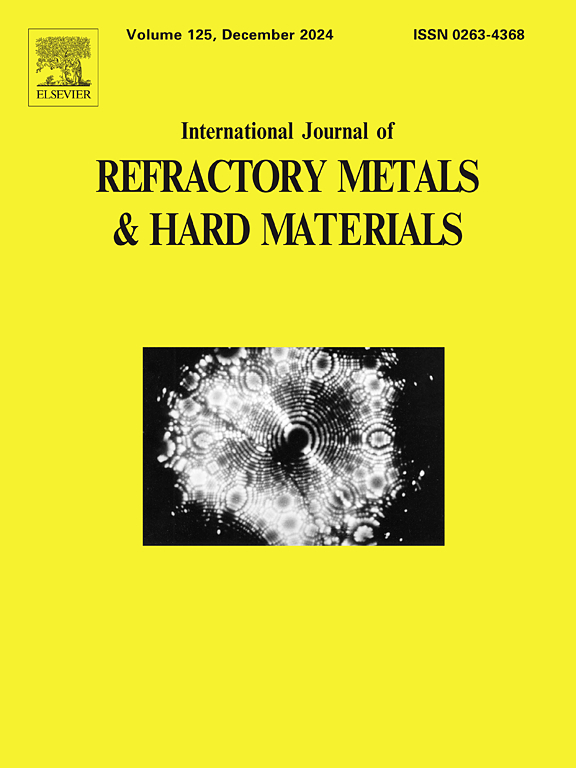Numerical simulation and electron beam welding process optimization of Ta2.5 W alloy
IF 4.2
2区 材料科学
Q2 MATERIALS SCIENCE, MULTIDISCIPLINARY
International Journal of Refractory Metals & Hard Materials
Pub Date : 2025-03-26
DOI:10.1016/j.ijrmhm.2025.107166
引用次数: 0
Abstract
In this study, finite element analysis software Marc was used for numerical simulation of electron beam welding of Ta2.5 W and then welding tests were carried out. The temperature change and equivalent stress distribution were analyzed and discussed during the welding simulation. When conducting welding experiments, welding beam and welding speed were adjusted based on the morphology of welded joints. Afterwards, in order to investigate the microstructure, phase composition, texture, mechanical properties and the fracture mode of Ta2.5 W weld joints, related testing and characterization methods were carried out. The temperature field simulation results indicate that the peak temperature variation in the middle section of the weld is relatively stable, approximately maintaining at 4000 °C; the stress field simulation results indicate that there is an equivalent Von Mises stress of around 500 MPa in the center of the weld. Microstructural observation shows that increasing the welding beam and decreasing the welding speed properly could obtain a welded joint with good melt width on the front and back sides. According to EBSD, all the regions of welded specimen exhibit a {111} // Z fiber texture and the strength of texture is uneven, manifested as BM > FZ > HAZ. Mechanical performance testing shows that specimen 4 (welding voltage: 150KV, welding beam current: 5 mA, welding speed: 400 mm/min) performs the best in welded specimens, its ultimate tensile strength (UTS) and yield strength (YS) are 381 MPa and 353 MPa respectively, reaching 70 % of the strength of BM. However, the elongation is only 3.75 %. The fracture observation shows welded joint exhibits quasi-dissociative fracture, and nano-sized spherical particles (TaCx or Ta2O5) are found in the fracture. We speculate that its fracture occurs in FZ as a result of the combined effect of the presence of large residual stresses at the weld, the coursening of the center of the weld at the high-angle grain boundaries, and the inhomogeneous distribution of second-phase particles.
Ta2.5 W合金的数值模拟及电子束焊接工艺优化
本研究采用有限元分析软件Marc对Ta2.5 W的电子束焊接进行数值模拟,并进行焊接试验。对焊接模拟过程中的温度变化和等效应力分布进行了分析和讨论。在进行焊接实验时,根据焊接接头的形貌调整焊接梁和焊接速度。随后,为了研究Ta2.5 W焊接接头的显微组织、相组成、织构、力学性能和断裂方式,进行了相关的测试和表征方法。温度场模拟结果表明:焊缝中部的峰值温度变化相对稳定,大致保持在4000℃;应力场模拟结果表明,焊缝中心存在500 MPa左右的等效Von Mises应力。显微组织观察表明,适当增大焊接梁和降低焊接速度可获得前后均有良好熔体宽度的焊接接头。根据EBSD,焊接试样各区域均呈现{111}// Z纤维织构,织构强度不均匀,表现为BM >;FZ祝辞热影响区。力学性能试验表明,试件4(焊接电压为150KV,焊接电流为5 mA,焊接速度为400 mm/min)在焊接试样中表现最好,其极限抗拉强度(UTS)和屈服强度(YS)分别为381 MPa和353 MPa,达到了BM强度的70%。而伸长率仅为3.75%。断口观察表明,焊接接头呈准解离性断裂,断口内存在纳米级球形颗粒(TaCx或Ta2O5)。我们推测其在FZ发生断裂是焊缝处存在较大残余应力、焊缝中心在高角度晶界处的偏转以及第二相颗粒分布不均匀等综合作用的结果。
本文章由计算机程序翻译,如有差异,请以英文原文为准。
求助全文
约1分钟内获得全文
求助全文
来源期刊
CiteScore
7.00
自引率
13.90%
发文量
236
审稿时长
35 days
期刊介绍:
The International Journal of Refractory Metals and Hard Materials (IJRMHM) publishes original research articles concerned with all aspects of refractory metals and hard materials. Refractory metals are defined as metals with melting points higher than 1800 °C. These are tungsten, molybdenum, chromium, tantalum, niobium, hafnium, and rhenium, as well as many compounds and alloys based thereupon. Hard materials that are included in the scope of this journal are defined as materials with hardness values higher than 1000 kg/mm2, primarily intended for applications as manufacturing tools or wear resistant components in mechanical systems. Thus they encompass carbides, nitrides and borides of metals, and related compounds. A special focus of this journal is put on the family of hardmetals, which is also known as cemented tungsten carbide, and cermets which are based on titanium carbide and carbonitrides with or without a metal binder. Ceramics and superhard materials including diamond and cubic boron nitride may also be accepted provided the subject material is presented as hard materials as defined above.

 求助内容:
求助内容: 应助结果提醒方式:
应助结果提醒方式:


